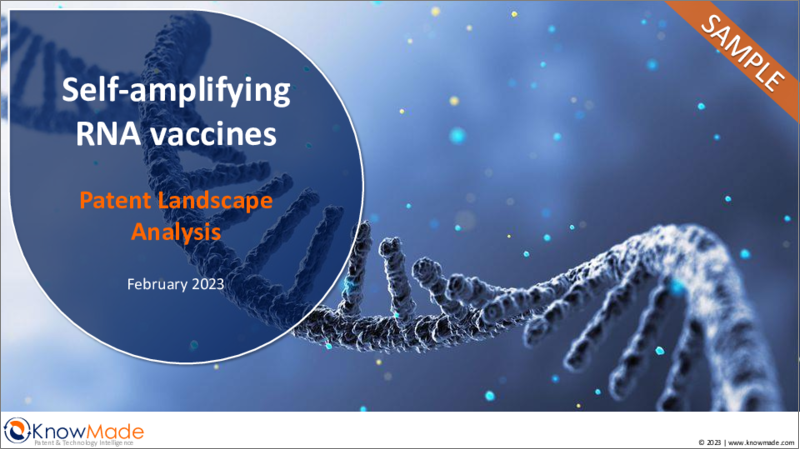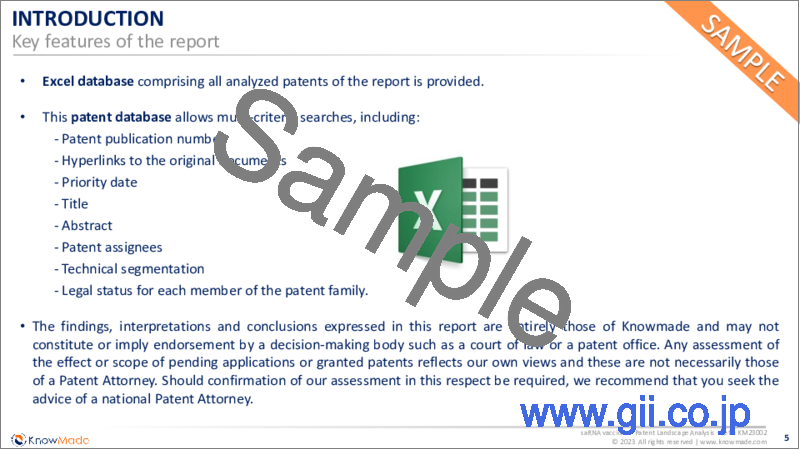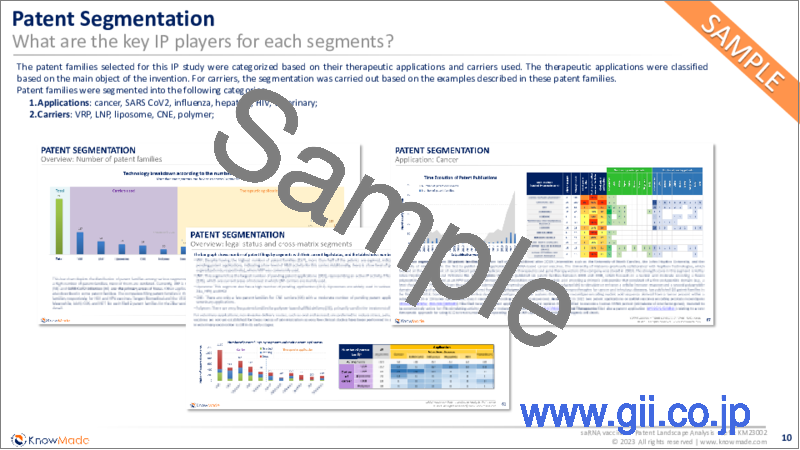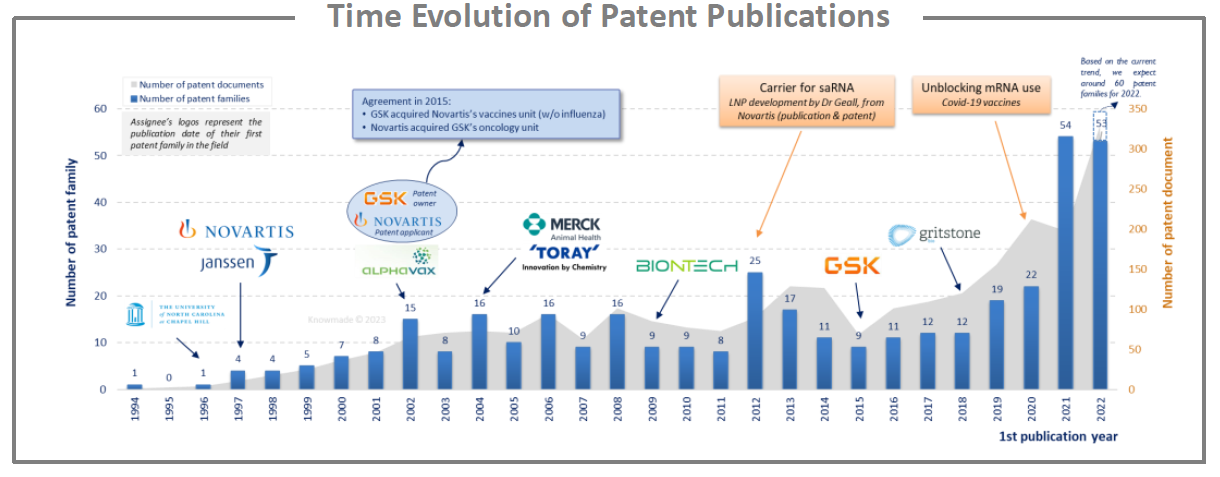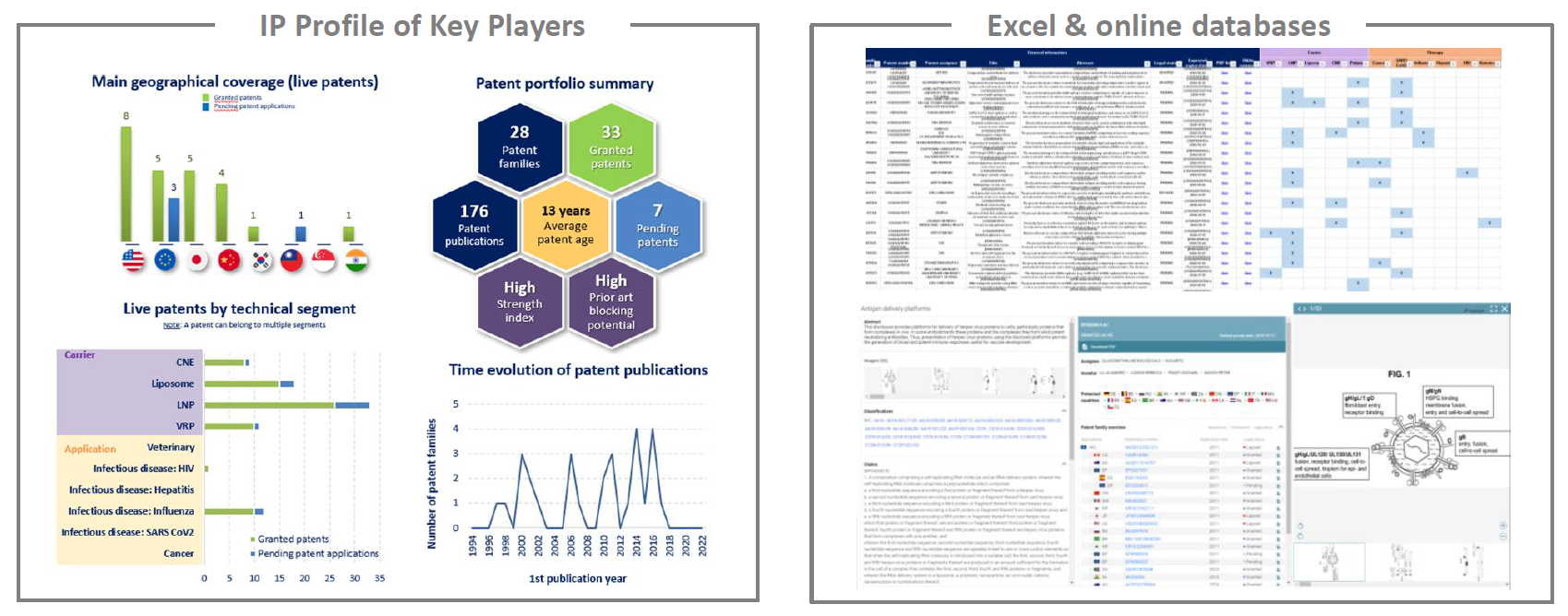|
|
市場調査レポート
商品コード
1223533
自己増幅型RNAワクチンの特許情勢分析:2023年Self-amplifying RNA Vaccines Patent Landscape Analysis 2023 |
||||||
| 自己増幅型RNAワクチンの特許情勢分析:2023年 |
|
出版日: 2023年02月23日
発行: KnowMade
ページ情報: 英文 PDF > 100 slides, Excel file: 392 patent families
納期: 即日から翌営業日
|
- 全表示
- 概要
- 目次
主な特徴
- PDF(100スライド以上)
- 報告書で分析した全特許を含むエクセルデータベース(セグメンテーションを含む)+更新されたオンラインデータベースへのハイパーリンク(法的ステータス、文書など)
- 公開特許の時系列推移、特許出願国、特許の法的ステータスなどの知財動向
- 主な特許譲受企業のランキングと特許技術の分析
- 主要プレーヤーのIPポジションと特許ポートフォリオの相対的強さ
- 治療用途の概要:がん、SARS CoV2、インフルエンザ、肝炎、HIV、獣医学
- saRNAカプセル化に使用されるキャリアの概要:VRP、LNP、リポソーム、CNE、ポリマー
- 新規参入企業とスタートアップ企業の特定
- 共同研究およびEP特許の異議申立の分析
- 主要特許の選択(引用度の高い特許、クレーム範囲の広い特許)
レポートの背景
パンデミックは研究努力と世界の協調をもたらし、結果としてmRNAワクチンの開発とヒト臨床試験が急速に進展しました。現在、mRNAワクチンには主に2つのタイプがあります。:従来の非増幅型mRNAと自己増幅型mRNA(saRNAまたはレプリコン)です。saRNAは非増幅型mRNAよりも大きく、RNAウイルスベクター由来の自己複製活性を維持しています。saRNAワクチンには、複製に必要な抗原コード配列とウイルスRNAポリメラーゼコード配列が含まれています。自己複製するアプローチの利点は、より少量のmRNAで有意に多量の抗原を発現させることができ、抗原の長期発現を達成できることです。より強い免疫応答、より少ないワクチン投与量、副作用の軽減といった臨床的な利点に加え、saRNAは製造レベルでも利点があります。saRNAワクチン・プラットフォームは、mRNAワクチンと比較して製造生産性が高く、用量あたりのコストが低い可能性があります。ヒトsaRNAワクチンにおいて、最も進んだ応用は、がんやSARS-CoV2に対する治療ワクチン接種であり、それぞれsaRNAが腫瘍抗原(特異的または関連)またはスパイクタンパク質をコードしています。さらに、この革新的で安価な治療法は、コンパニオンアニマルや家畜に対する治療で獣医学分野にも応用される傾向にあります。saRNAワクチンの他の主な用途は、インフルエンザ、肝炎、HIVなどの感染症に対するものです。現在、進行中の臨床試験は100件以下ですが、このテーマへの関心の高さと企業にとっての経済的利益を反映して、この数は増加傾向にあります。しかし、現在までのところ、EPおよび米国市場にはまだ製品がありませんが、主要特許に対してはすでにいくつかの特許異議申立が開始されています。ここでは13件のEP異議申立手続きが確認されていますが、そのほとんどは過去5年間に提出されたもので、現在も係属中です。特許をめぐるこのような初期の緊張と、急速に成長する技術環境では、さまざまなプレーヤーの知的財産(IP)スタンスと戦略を理解することが不可欠です。このような洞察は、ビジネスリスクとビジネスチャンスを見極め、来るべき技術を予見し、市場での地位を強化するための戦略的決定を可能にします。
特許公開の時間的変遷を分析すると、saRNAへの関心は1990年代初頭に始まりましたが、大きな牽引力にはならなかったことがわかります。しかし2012年、一部の科学者が、ウイルス粒子を使う代わりに脂質ナノ粒子(LNP)に大きなsaRNAをカプセル化する最初の機会をつかみました。これはNovartisの研究者によって強く提案されたもので、LNPにカプセル化された9kbのsaRNAは、ウイルス送達技術に匹敵する広範で強力な防御的免疫応答を引き起こしますが、その固有の限界はないことを示しました。2つ目の決定的な出来事は、2020年のCOVID-19パンデミックの際にmRNAがヒト治療に使用され、最初のmRNA COVID-19ワクチンの開発につながったことです。これら2つの出来事により、saRNA技術は完全に発展し、2021年と2022年に公開された特許ファミリーの数が大幅に増加し、2021年から2022年にかけて倍増しました。
セグメント別分析
saRNAワクチンが調査され、選択されたパテントファミリーが関連する技術に従ってラベル付けされました。このIP情勢は以下の2種類のセグメンテーションを特徴としています。:治療用途(発明の主な対象に基づく)とキャリア(どのデリバリーシステムが使用されるかを説明する例に基づく)。治療用途はがん、SARS-Cov-2、HIV、肝炎、インフルエンザ、獣医学に分けられ、キャリアはVRP、LNP、リポソーム、CNE、ポリマーに分けられています。
EP異議申立
企業にとってのsRNAワクチンの戦略的重要性を反映し、EP異議申立の件数がかなり多いです。ほとんどの異議申立は過去5年以内になされた最近のもので、現在も係属中です。各異議申立特許について、出願日、譲受人、異議申立人、異議申立年、結果が詳細に記載されています。さらに現在、米国と欧州で225件の特許が成立しています。付与された特許のそれぞれについて、最初のクレームの範囲の分析を手作業で行っています。この分析により、権利者に広範な保護を与えるクレームが付与された44件の特許を特定することができました。これらの特許の詳細(付与日、予想される有効期限、クレームされている主な概念)は当レポートに記載されています。
IP情勢に最近出現した企業の特定
saRNAワクチンに関連する特許ファミリーを所有する企業のうち、21の新規参入企業が特定されました。これらの企業はスタートアップ企業(8社)または既存企業(13社)で、saRNA分野で初めての技術を開発しています。これらの技術は主にSARS-CoV-2とがんに関連しています。多くの新規IP企業は米国に拠点を置いているが、欧州やアジアに拠点を置く企業もあます。これらの革新的な企業の1つが、大企業が買収したくなるような次のヘルスケアユニコーンの1つになる可能性があります。
主要企業の知財プロファイル
この知財調査には、主要企業の選定と説明が含まれています。主要企業の特許ポートフォリオ分析には、譲受人の説明、特許ポートフォリオの説明、特許公開の時間推移、主な地域分析、技術セグメント別のライブ特許が含まれます。この知的財産プロファイルの概要に続いて、主要特許の技術的内容の説明と臨床試験の表が掲載されています。
さらに、本レポートには、本調査で分析した392件の特許ファミリーのエクセルデータベースも含まれています。この便利な特許データベースは、多基準検索が可能で、特許公開番号、原文へのハイパーリンク、優先日、タイトル、要約、特許譲受人、各特許の現在の法的地位、セグメンテーションを含んでいます。
当レポートは、自己増幅型RNAワクチンの特許情勢について調査し、セグメント別の特許出願動向、主要企業のIPプロファイルなどについてまとめています。
目次
イントロダクション
エグゼクティブサマリー
特許情勢の概要
新規参入者
- スタートアップ企業
- 老舗企業
コラボレーション
主な出願人の知財位置
- 特許出願者の知財リーダーシップ
- 特許出願人をブロックする知財先行技術
- 特許ポートフォリオの強み指数
- 主な特許
広範な特許請求範囲で付与された米国のEP特許
特許のセグメンテーション
- 意味
- 技術別パテントファミリー数
- キャリア概要
- キャリアキー特許
- 癌
- SARS CoV 2
- インフルエンザ
- 肝炎
- HIV
- 獣医学
主要企業のIPプロファイル
- AlphaVax
- BioNTech
- Gritstone bio
- GSK
- Janssen
- Merck - Animal Health
- Novartis
調査手法
既知のプレゼンテーション
連絡先
Key Features:
- PDF>100 slides
- Excel database containing all patents analyzed in the report, including segmentations + hyperlink to updated online database (legal status, documents etc.)
- IP trends, including time evolution of published patents, countries of patent filings and patents' legal status
- Ranking of main patent assignees & analysis of their patented technologies
- Key players' IP position and relative strength of their patent portfolios
- Summary of the therapeutic applications: cancer, SARS CoV2, influenza, hepatitis, HIV, veterinary.
- Summary of the carriers used to saRNA encapsulation: VRP, LNP, liposome, CNE, polymer.
- Identification of newcomers and start-up firms.
- Analysis of collaborations and EP patent oppositions.
- Key patent selection (highly cited & granted patents with broad claims)
Report context
The pandemic has led to research effort and global coordination, resulting in the rapid development of mRNA vaccines and human clinical trials. Currently, there are 2 main types of mRNA vaccines: conventional non-amplifying mRNA and self-amplifying mRNA (saRNA or replicons). saRNAs are larger than non-amplifying mRNAs and maintain auto-replicative activity derived from an RNA virus vector. saRNA vaccines contain an antigen-encoding sequence and viral RNA polymerase-encoding sequence required for replication. The advantage of the self-replicating approach is that significantly higher amount of antigen can be expressed with lower doses of mRNA, and it achieves longer term expression of the antigen. In addition to clinical benefits such as stronger immune responses, lower vaccine doses and reduced adverse effects, saRNA would have advantages at manufacturing levels. The saRNA vaccine platform may have higher manufacturing productivity and lower cost per dose compared to mRNA vaccines. In human saRNA vaccine, the most advanced application is therapeutic vaccination against cancer or SARS-CoV2, with saRNA encoding tumor antigens (specific or associated) or spike proteins, respectively. Moreover, this innovative and less expensive therapy tends to apply to the veterinary area with treatments for companion animals and livestock. Main other applications of saRNA vaccine are directed against infectious diseases such as influenza, hepatitis and HIV. Currently, there are less than 100 clinical trials in progress, but this number is increasing, reflecting the interest in this topic as well as the economic stakes for companies. However, to date, there is still no product on the EP and US markets, but some patent oppositions have already been initiated against key patents. Thirteen EP opposition proceedings have been identified herein, most of which were filed in the past 5 years and are still pending. With these initial tensions concerning patents and in a swiftly growing technological environment, it is essential to comprehend the Intellectual Property (IP) stance and strategy of these different players. Such insight can help spot business risks and opportunities, foresee forthcoming technologies, and enable strategic decisions to bolster market position.
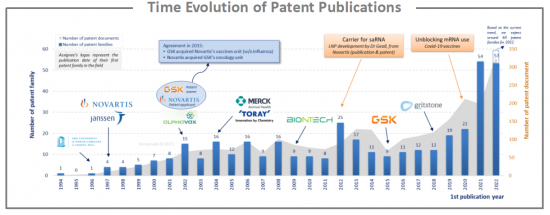
The analysis of the time evolution of patent publications shows that interest in saRNA began in the early 1990s, but it did not gain significant traction. However, in 2012, some scientists seized the first opportunity to encapsulate large saRNAs in lipid nanoparticles (LNP) instead of using viral particles. This was strongly proposed by Novartis researchers who showed that a 9 kb saRNA encapsulated in an LNP elicits broad, potent, and protective immune responses comparable to those of viral delivery technology, but without its inherent limitations. The second decisive event was the use of mRNA in human therapy during the COVID-19 pandemic in 2020, leading to the development of the first mRNA COVID-19 vaccine. These two events allowed saRNA technology to fully develop and led to a significant increase in the number of patent families published in 2021 and 2022, which doubled from 2021 to 2022.
Analysis by segment
saRNA vaccines have been investigated and the selected patent families labeled according to technologies to which they relate. This IP landscape features the following 2 types of segmentation: therapeutic applications (based on the main object of the invention) and carriers (based on examples describing which delivery systems are used). The therapeutic applications are divided into cancer, SARS-Cov-2, HIV, hepatitis, influenza and veterinary, while the carriers are separated into VRP, LNP, liposome, CNE and polymer.

EP oppositions
There is a significant number of EP oppositions which reflects the strategic issues of sRNA vaccines for companies. Most of the proceedings are recent, having been filed in the past 5 years, and are still pending. For each opposed patent, the application date, assignee, opponent, opposition year, and results are detailed. Moreover, currently, 225 patents have been granted in the US and Europe. For each of these granted patents, an analysis of the scope of the first claim was carried out manually. This analysis made it possible to identify 44 patents with granted claims providing broad protection to their holders. These patents are detailed in this study (grant date, expected expiration date, and main concepts claimed).
Identifying the companies that have recently emerged in the IP landscape
Among the players owning patent families related to saRNA vaccines, 21 newcomers were identified. These companies are either start-up firms (8) or established companies (13) developing their first technology in the saRNA field. These technologies are mainly related to SARS-CoV-2 and cancer. Numerous IP newcomers are based in the U.S., while some are based in Europe and Asia. It is possible that one of these innovative companies could become one of the next healthcare unicorns that the big corporations will be tempted to acquire.
IP profile of key players
This IP study includes a selection and description of main players. The patent portfolio analysis of main players includes a description of the assignee, patent portfolio description, time evolution of patent publication, main geographical coverage and live patents by technical segment. This IP profile overview is followed by the description of the technological content of their key patents and by a table with its clinical trials.

Moreover, the report also includes an Excel database with the 392 patent families analyzed in this study. This useful patent database allows for multi-criteria searches and includes patent publication numbers, hyperlinks to the original documents, priority dates, titles, abstracts, patent assignees, each patent's current legal status and segmentation.
Companies mentioned in this report (non-exhaustive list):
ALPHAVAX, ARCTURUS THERAPEUTICS, BIONTECH, BOEHRINGER INGELHEIM - ANIMAL HEALTH, CSL - SEQIRUS, GRITSTONE BIO, GSK, JANSSEN, MERCK MSD, MERCK MSD - ANIMAL HEALTH, NOVARTIS, PFIZER, REPLIKUN BIOTECH, SANOFI, TENGEN BIOMEDICAL, TIBA BIOTECH, TORAY INDUSTRIES, etc.
TABLE OF CONTENTS
INTRODUCTION
- saRNA, a new tool in therapeutic area
- Scope of the report
- Reading guide
EXECUTIVE SUMMARY
PATENT LANDSCAPE OVERVIEW
- Time evolution of patent publications
- Time evolution by country of filing
- Ranking of most prolific patent applicants
- Current legal status of the main players
- Patent legal status of the corpus
- Mapping of main current IP holders
- Patenting activity of IP leading companies
- Time evolution of main patent assignees
NEWCOMERS
- Startup companies
- Established companies
COLLABORATIONS
IP POSITION OF MAIN APPLICANTS
- IP leadership of patent applicants
- IP prior art blocking potential of patent applicants
- Strength index of patent portfolios
- Key patents
GRANTED US EP PATENTS WITH BROAD CLAIMS
PATENT SEGMENTATION
- Definition
- Number of patent families by technology
- Carrier overview
- Carrier key patents
- Application cancer
- Application SARS CoV 2
- Application Influenza
- Application Hepatitis
- Application HIV
- Application veterinary
IP PROFILE OF KEY PLAYERS
- AlphaVax
- BioNTech
- Gritstone bio
- GSK
- Janssen
- Merck - Animal Health
- Novartis
METHODOLOGY
- Patent search, selection and analysis
- Search strategy
- Terminologies for patent analysis
- Strength and blocking potential
